
|
|

March 31, 2006
Towers from the North Country: The Big Trip, 2005
Part VIII: Milwaukee, Wisconsin, round two
By SCOTT FYBUSH
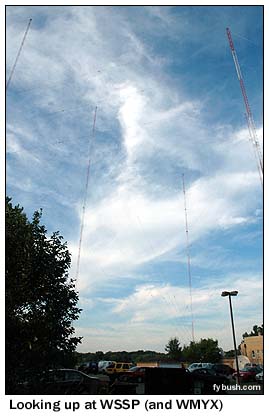 Once
every year or so, your editor gets together with other similarly
radio-crazed folk for an event that's become known as "The
Big Trip" - a week (or more) of dawn-to-dusk (and sometimes
beyond) traveling in search of interesting new sites to showcase
here on Tower Site of the Week, in the Tower Site Calendar, and
so on. It's a chance for us to meet people we've only corresponded
with via e-mail, and to gather airchecks and legal IDs for our
new content partners at www.tophour.net,
too. (In our version of a sitcom crossover episode, we're posting
the legal IDs from each Friday's Tower Site installment the following
Wednesday on Tophour - check it out!)
Once
every year or so, your editor gets together with other similarly
radio-crazed folk for an event that's become known as "The
Big Trip" - a week (or more) of dawn-to-dusk (and sometimes
beyond) traveling in search of interesting new sites to showcase
here on Tower Site of the Week, in the Tower Site Calendar, and
so on. It's a chance for us to meet people we've only corresponded
with via e-mail, and to gather airchecks and legal IDs for our
new content partners at www.tophour.net,
too. (In our version of a sitcom crossover episode, we're posting
the legal IDs from each Friday's Tower Site installment the following
Wednesday on Tophour - check it out!)
One of the real highlights of our August 2005 trip was our whirlwind swing around Milwaukee, a market we'd never visited before. As you may recall from last week's episode, we were fortunate, as the trip was coming together, to be in contact with several Milwaukee engineers with a passionate interest in radio history, including Kent Winrich at Clear Channel and Chris Tarr at Entercom. After beginning our Milwaukee visits on the afternoon of Wednesday, August 17 at the WTMJ "Radio City" facility, we headed west to the Clear Channel studios and WOKY (920) transmitter facility - and that's where we wound up at the end of last week's edition.
So we start this week just a couple of miles away, at the Hales Corners facility that's home to the studios of Entercom's sports WSSP (1250), AC WMYX (99.1) and top 40 WXSS (103.7 Wauwatosa), where Chris is our tour guide for a most interesting visit.
Explaining the history of this site requires us to dip very deeply into the wells of old Milwaukee radio history (and, frankly, a couple of cold Old Milwaukees wouldn't hurt afterward) - and we're indebted to Dick Golembiewski and his Milwaukee Horror Hosts site for helping to clear a lot of it up.
In a nutshell, this facility was originally built for a station called WMAW, which came on the air at 1250 just after World War II, with a seven-tower array at this same site. Along the way, WMAW ended up in the hands of broadcast entrepreneur Lou Poller, who renamed the station WCAN and then became involved in an early TV adventure, putting WCAN-TV 25 on the air in 1953 as a CBS affiliate. We'll hear more about WCAN-TV's brief history later - for now, the key point is that after WCAN-TV failed, Poller sold WCAN radio to Milwaukee Broadcasting, which owned WEMP (1340). WEMP moved to 1250, became a major force in Milwaukee radio for a while, and WCAN was history.
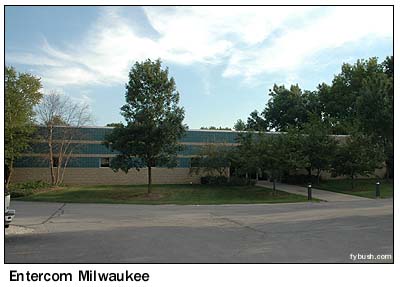 |
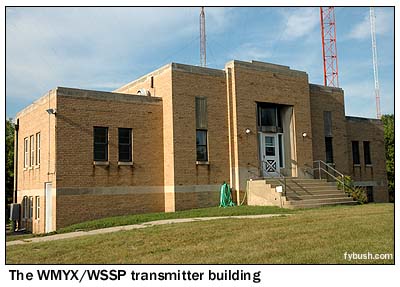
|
In 1960, WEMP rebuilt this site with the present five towers, adding WEMP-FM on 99.1 from one of the towers. Much later on WXSS joined the family, with a new studio/office building (shown above at left) being built between the old building (above at right) and West Grange Avenue.
A few years ago, the WEMP calls went away, replaced by "Sports Radio 1250," WSSP. Remember our stop at WAUK (1510) last week, and our mention of the unusual programming strategy there that puts WAUK's sports programming on the 1510 daytime facility when the sun is out, moving to leased time on WMCS (1290 Greenfield) at night? WSSP plays off that by proudly proclaiming itself "Milwaukee's Full-Time Sportsradio Station." Across the hall from WSSP's spacious studio is the studio for WXSS, which was calling itself "Kiss" long before Clear Channel was using the name nationally.
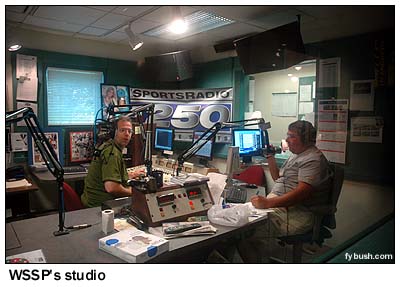
|
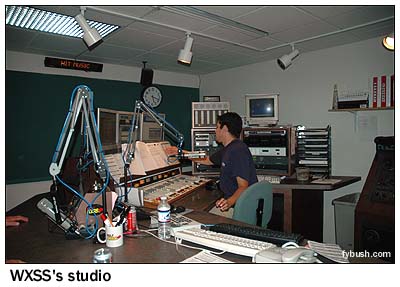
|
New studios are nice - but we're here for the history, and that's out in the old building. Walk right in the front door, and you're standing in a big room with glass separating you from an L-shaped array of transmitters for WSSP and WMYX, including a gorgeous old RCA that still serves as a very useful backup for WSSP's current Harris. To the right of the transmitter room are old studios for WEMP, now being used as storage - and down in the basement we find several more studios that were once used for production back in the day.
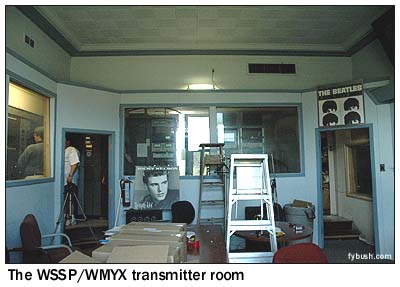
|
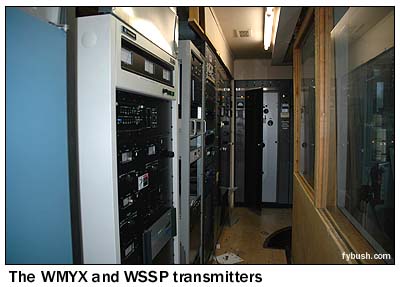
|
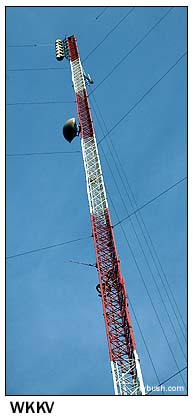 One
more note on that nifty transmitter room before we head on -
one of Chris' long-term projects is to clear out that space and
renovate it as a live-performance studio for the two FM stations.
What a neat room that will be!
One
more note on that nifty transmitter room before we head on -
one of Chris' long-term projects is to clear out that space and
renovate it as a live-performance studio for the two FM stations.
What a neat room that will be!
The focus of the visit next turned back to more of Kent's Clear Channel facilities, starting a few miles to the south, just across the Racine County line a little east of US 45, at the tower of WKKV (100.7 Racine), Clear Channel's urban station.
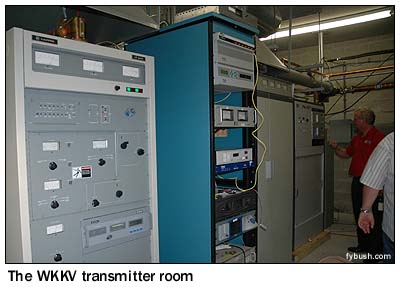 This
was Kent's first FM in town to go digital, and if you look carefully,
you can see Kent adjusting the BE digital transmitter at the
right side of the photo.
This
was Kent's first FM in town to go digital, and if you look carefully,
you can see Kent adjusting the BE digital transmitter at the
right side of the photo.
Another couple of miles to the south on US 45 brings us to Bennett Road, and that's where we see one of only two nine-tower AMs we'll find on this trip.
Interestingly - and more than just coincidentally - both of the stations in question are on 1130, a crowded channel indeed in the midwest. In Detroit, the nine towers of WDFN send that station's 10 kW night signal straight north. Over in Minneapolis, the nine towers of KFAN send its 25 kW straight north. And that leaves just enough room in the middle for WISN in Milwaukee, which was a 5 kW fulltimer on 1150 until the mid-fifties, when it went to 50 kW day, 10 kW night and built its current nine-tower facility way down here in Racine County.

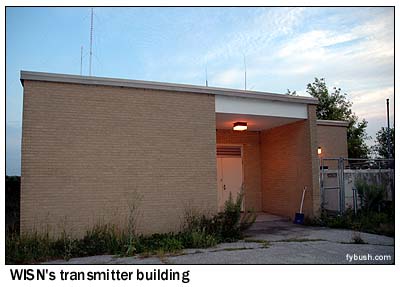 |
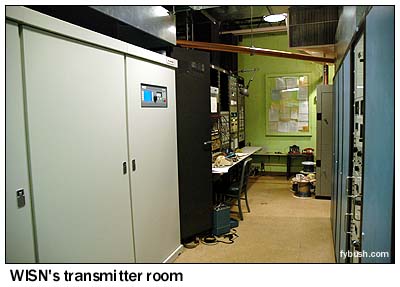
|
Especially by fifties standards, this is a pretty small building for a 50 kilowatt station, and even today there's not a lot of wiggle room inside. Two rows of transmitters greet you as you walk in - the new Harris 3DX50 shown at left in the picture above, and an older Nautel next to that.
There are impressive control panels for both the six-tower daytime operation and the nine-tower nighttime phasor. But where are the actual phasors? Kent unlocks a door at the back of the building, and there they are - daytime on one wall, nighttime on the other!
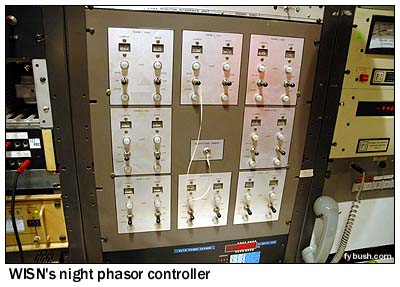 |
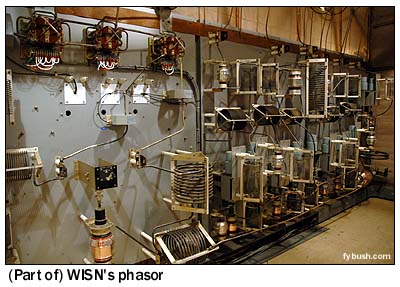
|
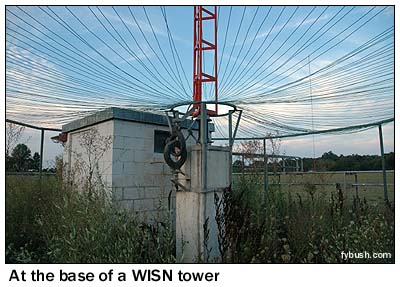 As the
sun begins to set, we head out into the tower field to get a
closer look at the nine-tower array, including that interesting
overhead ground screen around each tower base.
As the
sun begins to set, we head out into the tower field to get a
closer look at the nine-tower array, including that interesting
overhead ground screen around each tower base.
Before it gets completely dark, there's still one more site to get a quick look at.
In last week's episode of Site of the Week, we saw the studios of WTMJ (620), and now it's time to see where that signal comes from. Until a few years ago, WTMJ was a typical 5 kW regional signal, transmitting from the same site on Bluemound Road in Brookfield, west of Milwaukee, that it had used since 1927.
When the 5 kW power limit on regional channels was lifted, though, WTMJ was the very first station in line for an upgrade, winning permission in 1995 to go to 50 kW days, 10 kW nights from a new six-tower site about a mile and a half south of the WISN site. All six towers are used at night, sending the signal in a fairly tight beam north; by day, the four-tower pattern aims mostly north, but the signal's still pretty good as far south as Chicago's northern suburbs. We'll go back and see the inside of the current WTMJ site on a future visit to Milwaukee; sadly, we're told that the 1927 Brookfield site is completely gone, replaced by a housing development.
(One more historical note about WTMJ: back in 1932, it was WTMJ's protected status on 620 that led to the development of the very first modern AM directional antenna system, as WFLA-WSUN in Tampa went directional to protect Milwaukee.)

All that, and we still haven't actually had dinner, so we stop on the way back up toward the city to dine with Kent and Chris before calling it quits for the night.
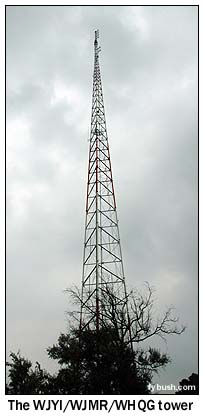 The
next morning - Thursday, August 18 - dawned gray and rainy, so
it's probably just as well that most of our remaining Milwaukee
stops were indoors.
The
next morning - Thursday, August 18 - dawned gray and rainy, so
it's probably just as well that most of our remaining Milwaukee
stops were indoors.
First on our morning agenda was the other major group-owned radio cluster in Milwaukee, the Saga Communications facility at 5407 W. McKinley that's home to gospel WJYI (1340), classic rock WKLH (96.5), urban AC WJMR (98.3 Menomonee Falls), classical WFMR (106.9 Brookfield) and the big signal at 102.9 that was just in the midst of moving from "Lazer" WLZR to "The Hog," WHQG.
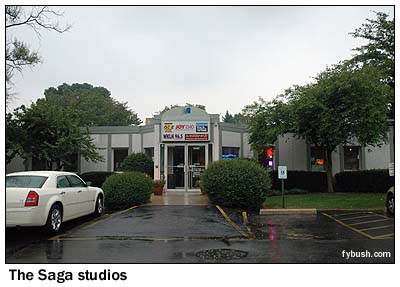 Those
new calls were just a few hours old when we pulled up in front
of the studio building, right next to the self-supporting tower
that carries WJYI, WJMR and 102.9.
Those
new calls were just a few hours old when we pulled up in front
of the studio building, right next to the self-supporting tower
that carries WJYI, WJMR and 102.9.
Inside, the lobby was full of neon station logos, with windows looking into the 102.9 studios on one side (where veteran morning team Bob and Brian were just wrapping up their show), and into WKLH on the other side. A half-flight of stairs led down to another part of the sprawling building, where WJMR has its own studios in one corner, WJYI sits near the engineering shop in another corner, and classical WFMR has its own pod of studios, as well as a well-stocked record library. (Our tour guide here is WFMR's PD/morning host, fellow New England expatriate Steve Murphy, who's built WFMR into a very successful medium-market commercial classical station at a time when so many other commercial classical stations are falling victim to the press for higher profit margins. It's nice to see WFMR still making a go of it here!)
A bit more history before we move on: the 1340 facility here was originally WEMP (which itself began on 1310 atop the Empire Building downtown before moving out here in the early fifties), and this tower was also home to another early Milwaukee UHF station, WOKY-TV (Channel 19), which signed on here in October 1953. When WEMP's owners bought the WCAN 1250 facility in 1955, 1340 became WRIT, which was one of the city's top-rated top-40 stations for many years. WOKY-TV, meanwhile, ended up being sold to CBS, which changed the station's calls to WXIX. We'll pick up its story again in a little bit.
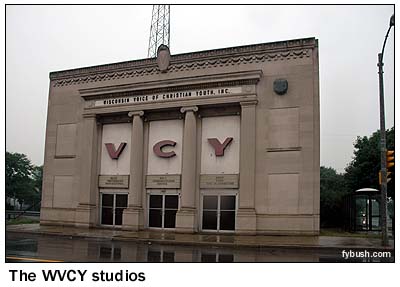 |
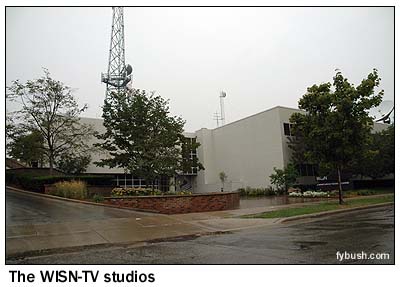
|
The rain's still pouring as we say goodbye to Steve and head into downtown Milwaukee, passing the studios of religious WVCY-TV (Channel 30) in what appears to be a former bank building on W. Vliet Street, a few blocks from the VCY America offices and radio studios on W. Kilbourne. We pass the Pabst Mansion on Wisconsin Avenue, and right around the corner on N. 19th Street is the blocky studio of WISN-TV (Channel 12), Milwaukee's ABC affiliate, still in the hands of Hearst (through subsidiary Hearst-Argyle Television) long after WISN radio was sold off.
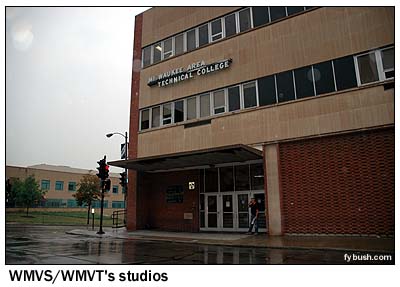 Another
few blocks to the east, across the I-43 construction zone, we
come to the campus of Milwaukee Area Technical College, where
the building to the right houses the studios of Milwaukee's two
public television stations, WMVS (Channel 10) and WMVT (Channel
36). We drive through downtown in the rain to see some of the
architecture, as well as to catch a glimpse (but alas, not a
good photo) of the tower atop the old Schroeder (now Hilton)
Hotel, one of the most interesting spots in Milwaukee's TV history.
This tower began its life, according to Dick Golembiewski, out
at the Hales Corners site of WMAW, where it was briefly used
by the early WMAW-FM before being deemed a navigation hazard
and dismantled. It was re-erected a few years later atop the
Schroeder, then the city's tallest building, for Lou Poller's
WCAN-TV (Channel 25). But WCAN-TV didn't last very long, losing
its CBS affiliation to CBS' own WXIX (Channel 19) in late 1954,
at which point Poller threw in the towel, taking WCAN-TV dark
and selling its facilities atop the Schroeder and its brand new
studios at 5445 N. 27th Street to CBS, which moved WXIX there.
Another
few blocks to the east, across the I-43 construction zone, we
come to the campus of Milwaukee Area Technical College, where
the building to the right houses the studios of Milwaukee's two
public television stations, WMVS (Channel 10) and WMVT (Channel
36). We drive through downtown in the rain to see some of the
architecture, as well as to catch a glimpse (but alas, not a
good photo) of the tower atop the old Schroeder (now Hilton)
Hotel, one of the most interesting spots in Milwaukee's TV history.
This tower began its life, according to Dick Golembiewski, out
at the Hales Corners site of WMAW, where it was briefly used
by the early WMAW-FM before being deemed a navigation hazard
and dismantled. It was re-erected a few years later atop the
Schroeder, then the city's tallest building, for Lou Poller's
WCAN-TV (Channel 25). But WCAN-TV didn't last very long, losing
its CBS affiliation to CBS' own WXIX (Channel 19) in late 1954,
at which point Poller threw in the towel, taking WCAN-TV dark
and selling its facilities atop the Schroeder and its brand new
studios at 5445 N. 27th Street to CBS, which moved WXIX there.
(Poller received the old WOKY-TV 19 transmitter facilities as part of the deal, and he retained the license to channel 25, later moved to 24, well into the late sixties. The transmitter ended up being donated to MATC to become the first WMVT transmitter, and Poller ended up filing an antitrust suit against CBS, which lingered for a few years before being decided in CBS' favor.)
CBS, meanwhile, sold WXIX (by then on channel 18) and moved its affiliation to one of the city's new VHF stations, WITI (Channel 6), which signed on in 1956. WXIX operated as an independent, later changing calls to WUHF and then, under Gaylord, to its present calls, WVTV. And after it left the hotel roof for a tower just north of WTMJ-TV in the sixties, the old WCAN-TV tower found yet another new life, becoming home to independent WDJT (Channel 58) in the eighties. Head spinning yet? It gets worse - when WITI ended up under Fox ownership in 1994, WDJT became the CBS affiliate, and so CBS was once again broadcasting from that same hotel roof. (It later built a tall tower in Lincoln Park, which we'll see in a bit.)
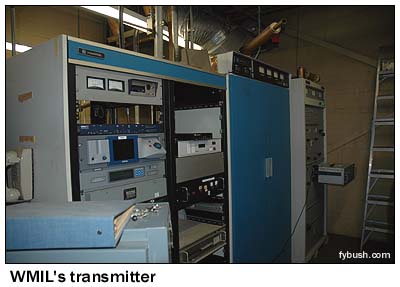 |
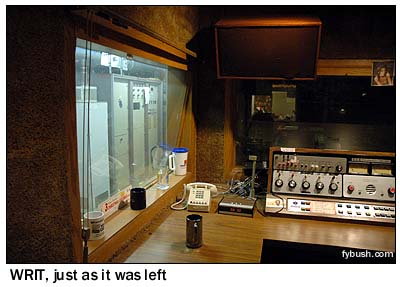 |
With the rain still coming down in sheets, our next stop is back over in the vicinity of WTMJ's Radio City, this time to meet up with Kent at the tower across Capitol Drive that's home to Clear Channel's WMIL (106.1 Waukesha) and the Milwaukee Radio Alliance's WJZI (93.3). They share a transmitter room in an old factory building that's now mostly vacant, and both have CPs to move north to the nearby American Tower (WVTV) facilities. That would leave WCGV (Channel 24), for whom the tower was built, and WVCY-TV (Channel 30) as the last remaining broadcast tenant once that happens.
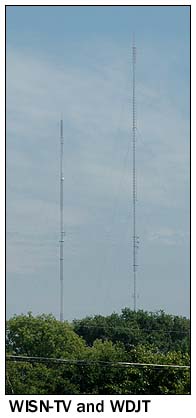
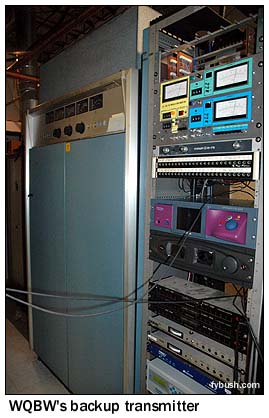 A half-mile west
on Capitol, Kent shows us the WRIT (95.7) transmitter, which
was once also the studio facility for "Oldies 95.7."
When the move to the current Clear Channel facilities took place
a few years ago, the old WRIT studios were essentially abandoned
in place, and there are still carts in the racks, coffee mugs
on the windowsills, and all the other things you'd have seen
in an FM station before the digital era.
A half-mile west
on Capitol, Kent shows us the WRIT (95.7) transmitter, which
was once also the studio facility for "Oldies 95.7."
When the move to the current Clear Channel facilities took place
a few years ago, the old WRIT studios were essentially abandoned
in place, and there are still carts in the racks, coffee mugs
on the windowsills, and all the other things you'd have seen
in an FM station before the digital era.
We're already on the north side of Milwaukee at this point, and as the sky slowly clears, we keep heading north.
About a mile from the Capitol Drive towers is Lincoln Park, which began its broadcast era with the 1954 debut of WTVW (Channel 12), the city's second VHF station, which started out with a 300-foot tower and a temporary studio in a tent. A year later, the current 1105-foot tower was completed, and Hearst changed the calls to the present WISN-TV.
We're here because of the former WISN-FM (97.3), which ended up in Clear Channel's hands as WLTQ, then relaunched a year or so ago with classic rock as "The Brew," WQBW. Amidst all those changes, it's still transmitting from the WISN-TV site, and we're amused by the juxtaposition between the old RCA backup transmitter and the state-of-the-art Optimod processor in the rack next to it.
We'd mentioned WDJT's move to Lincoln Park, and indeed, its current tower sits just to the west of the WISN-TV tower, carrying not only WDJT itself but also Weigel sister stations WMLW-CA (Channel 41), a very successful low-power indie, and Telemundo affiliate WYTU-LP (Channel 63).
The picture of the two towers was taken from N. 27th Street, right in front of the studio building that Lou Poller built way back in 1954 for WCAN-TV. This building had a fascinating history, which went more or less like this: after WCAN-TV folded, it was sold to CBS, which moved WXIX up here. When CBS got out of Milwaukee ownership in 1959, WXIX's new owners moved its studios to the transmitter site at the Schroeder, freeing up CBS to sell the studios to the network's new affiliate, WITI (Channel 6), which had been operating from studios at their transmitter site way up north of the city at Port Washington Road and Donges Bay Avenue. (That building still exists, according to Dick Golembiewski, and I'll have to check it out next visit.)
WITI stayed on N. 27th Street until 1978, when it built new studios at 9001 North Green Bay Road, a few miles to the northwest, and this building took on yet another new life in 1980, becoming home to new indie WCGV-TV (Channel 24).
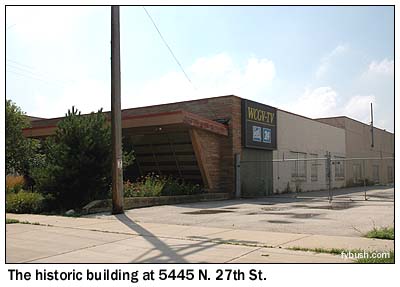 |
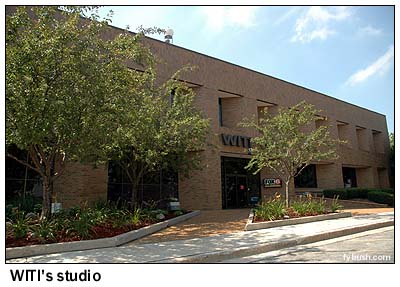
|
If your irony meter's not running at full tilt yet, consider this: the channel 24 allocation was the descendant of the original channel 25 where WCAN-TV operated, from this very building. And just to bring the irony full circle, when WCGV moved out a few years ago, it became a sister station to WVTV, the descendant of WXIX, which succeeded WCAN-TV at this location. And, yes, WCGV lost its original Fox affiliation to WITI, just as WCAN and then WXIX lost their CBS affiliation to WITI. (Which, by the way, had meanwhile traded affiliations with WISN-TV, becoming ABC, then swapping back in 1977.)
I believe there's now a video production firm at 5445 N. 27th, but the old "Fox 24" sign is still there on the side of the building. I wonder if there's a WCAN sign underneath that?
And that's it for Milwaukee - next stop, Fond du Lac, Oshkosh, Neenah-Menasha and Appleton! See you next week...
- Previous Site of the Week: The Minnesota/Wisconsin Big Trip, part VII: Milwaukee, round one
- Next Week: The Minnesota/Wisconsin Big Trip, Part IX: The Fox Cities
- Site of the Week INDEX
- How can you help support Site of the Week? Click here!
- Submit your suggestions for a future Site of the Week!
